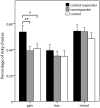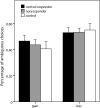Acute stress affects risk taking but not ambiguity aversion
- PMID: 24834024
- PMCID: PMC4018549
- DOI: 10.3389/fnins.2014.00082
Acute stress affects risk taking but not ambiguity aversion
Abstract
Economic decisions are often made in stressful situations (e.g., at the trading floor), but the effects of stress on economic decision making have not been systematically investigated so far. The present study examines how acute stress influences economic decision making under uncertainty (risk and ambiguity) using financially incentivized lotteries. We varied the domain of decision making as well as the expected value of the risky prospect. Importantly, no feedback was provided to investigate risk taking and ambiguity aversion independent from learning processes. In a sample of 75 healthy young participants, 55 of whom underwent a stress induction protocol (Trier Social Stress Test for Groups), we observed more risk seeking for gains. This effect was restricted to a subgroup of participants that showed a robust cortisol response to acute stress (n = 26). Gambling under ambiguity, in contrast to gambling under risk, was not influenced by the cortisol response to stress. These results show that acute psychosocial stress affects economic decision making under risk, independent of learning processes. Our results further point to the importance of cortisol as a mediator of this effect.
Keywords: ambiguity; cortisol; decision making; gain/loss domain; risk; stress; uncertainty.
Figures





References
LinkOut - more resources
Full Text Sources
Other Literature Sources

